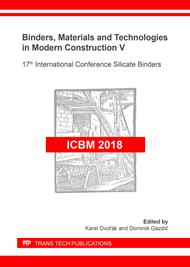[1]
J. Davidovits, Geopolymer chemistry and application, 3rd editon, Institute Geopolymer, France, (2011).
Google Scholar
[2]
J.L. Provis and J.S.J. van Deventer, Alkali Activated Materials: State of the art report. RILEM-TC244 AAM, Springer Dordrecht Heidelberg New York London, (2014).
DOI: 10.1007/978-94-007-7672-2
Google Scholar
[3]
N. Böke, G.D. Birch, S.M. Nyale, and L.F. Petrik, New synthesis method for the production of coal fly ash-based foamed geopolymers, Construction and Building Materials 75 (2015) 189-199.
DOI: 10.1016/j.conbuildmat.2014.07.041
Google Scholar
[4]
I. Ismail, S.A. Bernal, J.L. Provis, S. Hamdan, and J.S.J. van Deventer, Drying-induced changes in the structure of alkali-activated pastes, Journal of Materials Science 48 (2013) 3566-3577.
DOI: 10.1007/s10853-013-7152-9
Google Scholar
[5]
V.Q. Le, M.Q. Do, M.D. Hoang, T.P. Dang, T.H. Bui, H.T. Nguyen, Evaluation on Roles of Activated Silicon and Aluminum Oxides for Formation of Geopolymer from Red Mud and Silica Fume, Key Engineering Materials, 777 (2018) 513-517.
DOI: 10.4028/www.scientific.net/kem.777.513
Google Scholar
[6]
J. Melar, V. Bednarik, R. Slavik, and M. Pastorek, Effect of hydrothermal treatment on the structure of an aluminosilicate polymer, Central European Journal of Chemistry, 11 (5) (2013) 782-789.
DOI: 10.2478/s11532-013-0204-9
Google Scholar
[7]
F. Skvara, T. Jilek, and L. Kopecky, Geopolymer materials based on fly ash, Ceramics Silikáty, 49 (3) (2005) 195-204.
Google Scholar
[8]
M.S. Morsy, S.H. Alsayed, Y. Al-Salloum, and T. Almusallam, Effect of Sodium Silicate to Sodium Hydroxide Ratios on Strength and Microstructure of Fly Ash Geopolymer Binder, Arab Journal of Science Engineering, 39 (2014) 4333-4339.
DOI: 10.1007/s13369-014-1093-8
Google Scholar
[9]
E. Obonyo, E. Kamseu, U.C. Melo, and C. Leonelli, Advancing the Use of Secondary Inputs in Geopolymer Binders for Sustainable Cementitious Composites: A Review, Sustainability 3 (2) (2011) 410-423.
DOI: 10.3390/su3020410
Google Scholar
[10]
D. Panias and I.P. Giannopoulou, Development of inorganic polymer materials based on fried coal fly ash, Acta Metallurgica Slovaca 12 (2006) 321-327.
Google Scholar
[11]
H.T. Nguyen, T.N. Le, V.T.H.Q. Pham, T.P. Dang, T.K. Dao, V.P. Nguyen, Development of heat resistant geopolymer-based materials from red mud and rice husk ash, AIP Conference Proceedings, 1954, 040005 (2018).
DOI: 10.1063/1.5033414
Google Scholar
[12]
S.A. Bernal, E.D. Rodrı´guez, R.M. de Gutie´rrez, J.L. Provis, and S. Delvasto, Activation of Metakaolin/Slag Blends Using Alkaline Solutions Based on Chemically Modified Silica Fume and Rice Husk Ash, Waste biomass valorize 3 (2012) 99-108.
DOI: 10.1007/s12649-011-9093-3
Google Scholar
[13]
H.T. Nguyen, V.T.H.Q. Pham, T.P. Dang, T.K. Dao, Leachability of heavy metals in geopolymer-based materials synthesized from red mud and rice husk ash, AIP Conference Proceedings, 1954, 040014 (2018).
DOI: 10.1063/1.5033414
Google Scholar
[14]
C.A. Rees, Mechanisms and kinetics of gel formation in geopolymers, Dessirtation in The University of Melbourne (2007).
Google Scholar
[15]
X. Guo, W. Hu, and H. Shi, Microstructure and self-solidification/stabilization (S/S) of heavy metals of nano-modified CFA–MSWIFA composite geopolymers, Construction and Building Materials, 56 (2014) 81-86.
DOI: 10.1016/j.conbuildmat.2014.01.062
Google Scholar
[16]
Y. Hou, D. Wang, W. Zhou, H. Lu, and L. Wand, Effect of Activator and Curing Mode on Fly Ash-based Geopolymers, Journal of Wuhan University of Technolotgy-Mater. Sci. Ed., 24 (5) (2007) 711-715.
DOI: 10.1007/s11595-009-5711-3
Google Scholar
[17]
Y. Zhang, W. Sun, and Z. Li, Infrared Spectroscopy Study of Structural Nature of Geopolymeric Products, Journal of Wuhan University of Technology-Mater. Sci. Ed., 23 (4) (2007) 522-527.
DOI: 10.1007/s11595-007-4522-7
Google Scholar
[18]
P.J.A. Griffiths, and de Hasseth, Fourier Transform Infrared Spectrometry, 2nd edition, Published by Wiley-Blackwell Ltd, (2007).
Google Scholar


